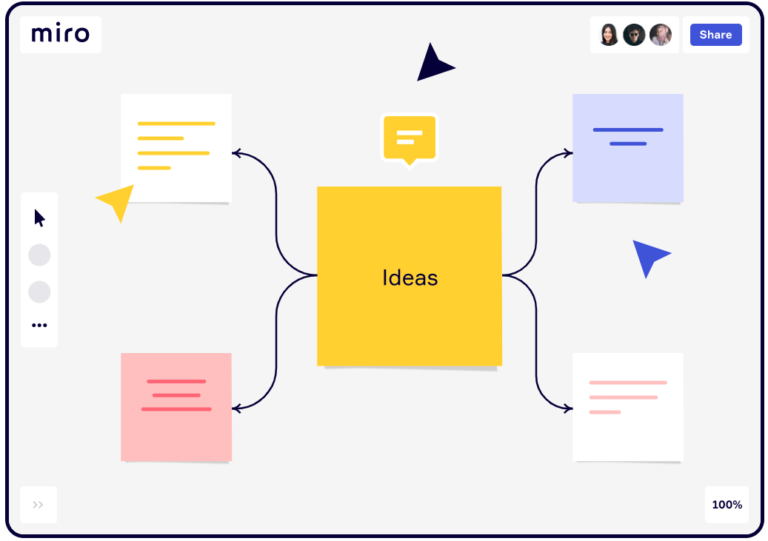Online whiteboards have become an essential component for team collaboration across industries. In the age of remote and hybrid work, businesses have the flexibility to build their teams without concerns about geographical limitations. And digital tools that support collaborative sessions allow teams to work harmoniously in real time despite the distances between them.
Among numerous such tools available these days, some are more popular than others. But if you have hosted a team collaboration session before, you are probably familiar with Mural, Microsoft Whiteboard, and Miro.
While MS Whiteboard is popular, our review shows it is far too basic to compete with leading online whiteboarding tools like Miro or Mural.
So, today we are giving you a detailed Miro vs. Mural comparison along with a surprise alternative recommendation. So read on to the very end.

Part 1. What is Miro?
Miro claims to be “your team’s visual platform to connect, collaborate, and create -- together.” It also boasts 45 million users, which is a big number but then the product has been in the market for years backed by a huge marketing budget, particularly since it was rebranded in 2019.

Miro allows teams to work together by collaborating on whiteboards in live sessions. One of the team members hosts the session and creates a blank whiteboard or adds initial designs or ideas using one of the many templates available.
Once the session is ready, the host creates a link for the whiteboard and shares the URL with their teammates, who can immediately join and participate.
Participants can be invited to a variety of whiteboards, including blank whiteboards for brainstorming ideas, drawing various types of diagrams, organizing scrum events, constructing process maps, visually conducting research and analysis, and more. You can also use this real-time whiteboarding tool to organize all sorts of online workshops for your teams and students.
Miro is available as a mobile app and for various internet browsers, which means you can easily access the whiteboards you are invited to on your phone or laptop.
Part 2. What is Mural?
Mural is a popular competitor of Miro’s. It was launched in 2019 and has, within this short period of time, established itself as a leading name in the constantly growing online whiteboard technology landscape. In the brand’s own words, “MURAL connects teams with a digital whiteboard and collaboration features designed to inspire innovation.”

That’s a very simplified version of what Mural allows its users to do. With this vision, Mural has become one of the superior online whiteboards available today. The brand boasts to be “trusted by 95% of the Fortune 100” companies, which is a big claim and makes it a serious contender.
In essence, Mural is designed with its popular whiteboard as the core tool packed with a ton of diagramming and collaboration features to help teams work together asynchronously as well as in real-time.
Part 3. Miro Vs Mural: Which Online Whiteboard is Better?
In this comparative review, we are going to discuss the various features and range of capabilities offered by Miro and Mural as online whiteboards.
3.1 Price
For a user subscribing to a software product, price plays a key role in the decision to buy.
With that in mind, here are the Miro vs. Mural pricing details:
| Pricing Plan | Miro | MURAL |
|---|---|---|
| #1 | Free: $0 /m | Free: $0 /m |
| #2 | Starter: $8 /m | Team+: $12 /m |
| #3 | Business: $16 | Business: $17.99 /m |
| #4 | Enterprise: Custom pricing | Enterprise: Custom pricing |
If you look at the difference in the two products' pricing options, you can see it is not significant when it comes to numbers. They both offer a free subscription plan that allows subscribers to use the platforms with limited functionality. For example, Miro’s free plan comes with 3 editable whiteboards, numerous templates, basic integration with other platforms and tools, and limited attention management.
On the other hand, Mural offers 3 whiteboards (which it calls murals), an unlimited number of participants, limited access to its templates library, and an infinite canvas for your murals in its free price plan.
The other pricing plans can be compared similarly. We have come to the conclusion that even when you compare the value you can get from any of these pricing plans, there is little difference between what Miro and Mural offer. Neither seems to have a clear advantage over the other in pricing.
3.2 Collaboration Features
Now that our Miro vs. Mural comparison has shown the pricing plans of these two platforms offer a lot of similar value, let’s move on to their key features and functionality.
Since these whiteboarding tools aim to deliver team collaboration for idea sharing, let us first compare their key collaboration features.
- Miro and Mural both offer virtually the same kind of basic features on their whiteboards. Both have an easy-to-use interface, though users who have tried both products often find Miro slightly easier to learn. Apart from that, the other basic whiteboarding features are pretty similar.
- Miro clearly offers a wider range of built-in templates on its whiteboard for all sorts of diagrams. Its preset diagrams are greater in number, which enables users to work with more accurate pre-formatted designs and easily replace captions to make them their own. However, both Miro and Mural offer complete customization in their template layouts.
- With unlimited free users and a simplified one-click view capability, Mural offers a stronger and simpler foundation for delivering workshops. Miro, in comparison, does not make the facilitation of whiteboards so easy, even though it is still quite simple to view and share Miro whiteboards.
- When it comes to ease of creating maps and diagrams, Miro has a clear edge over Mural, which nonetheless possesses a versatile arsenal of diagramming features.
- Some users have repeatedly complained that Mural’s performance takes a dip under pressure. When they are dealing with larger teams, hosts have observed lagging and other related issues, which is something we did not experience on Miro at all.
3.3 Integrated Features
Integration capability gives any app a major level-up these days. When you are comparing team collaboration tools, this quality becomes all the more important because more integrations mean more team members can easily use the tool and share their work via other apps they often use.
Miro offers a wide range of integration capabilities. The platform can be conveniently integrated with MS Teams, Adobe Suite, Google Drive, Salesforce, and Slack, to name the most popular brands.
Unfortunately, Mural is quite limited when it comes to app integrations and falls far behind in that race.
Part 4. Our Verdict: Who Wins?
We see a lot of people and businesses prefer Miro over others while many others choose Mural. So it comes down to the personal preferences of the decision-maker in any given team or business.
However, our comparative Miro vs. Mural review shows Miro is far ahead of Mural in terms of the quality and number of integrations and templates offered on the whiteboard. We attribute much of this advantage to the much more advanced Miro API and templates library, both of which of course benefit from the fact that Miro has been in the market for far longer than Mural.
In 2022 alone, Mural has covered much ground. It has made a lot of progress in terms of platform performance and collaboration capabilities with its sights set on further improvement.
We have no doubt it will become better with every new year, but Miro has to be considered the winner of this comparison, at least for now.
Part 5. A New FREE Miro Alternative: Boardmix
As a modern team leader and host of collaborative sessions, you might also want to consider Boardmix, which is establishing itself as a reliable free Miro alternative. The whiteboarding tool is new to the race but offers a wide range of collaborative, diagramming, and integration features that you may also find in Miro or Mural.

You can sign up for Boardmix for free and start creating simple-to-complex whiteboards with your team straight away.
In conclusion, while Miro may be deemed the winner in a Miro vs. Mural comparison, you should try out other, newer whiteboarding tools in the market as well. Some of these new tools, such as Boardmix, have a lot of promise and will likely become serious contenders for Miro and Mural soon.









